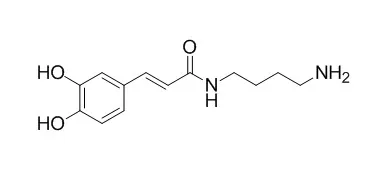| Structure Identification: |
| Phytochemistry (Oxford), 1996, 42(2):389-396. | | Changes in the accumulation of soluble and cell wall-bound phenolics in elicitor-treated cell suspension cultures and fungus-infected leaves of Solanum tuberosum.[Reference: WebLink] | Cell suspension cultures of potato (Solanum tuberosum cv. Datura) treated with an elicitor preparation from Phytophthora infestans and potato leaves infected with the same fungus were used to study changes in the accumulation patterns of soluble and cell wall-bound phenolics.
METHODS AND RESULTS:
The compounds were identified by chromatographic comparison with authentic substances and by spectroscopic methods (FAB mass spectrometry, 1H and 13C NMR). The soluble phenolics were 4-O-β-glucopyranosylhydroquinone (arbutin), 4-O-β-glucopyranosylbenzoate, 3-methoxy-4-O-β-glucopyranosylbenzoate (vanillate glucoside), N-(E)-caffeoylputrescine((E)-N-Caffeoylputrescine), 2-O-β-glucopyranosylbenzoate (salicylate glucoside), N-(E)-feruloylputrescine, and N-(E)-feruloylaspartate. The cell wall-bound phenolics were 4-hydroxybenzoate, 4-hydroxybenzaldehyde, 3-methoxy-4-hydroxybenzaldehyde (vanillin), 4-(E)-coumarate, (E)-ferulate, N-4-(E)-coumaroyltyramine, and N-(E)-feruloyltyramine.
CONCLUSIONS:
The most prominent phenolics showing elicitor- or fungus-induced increases in accumulation rates were the soluble putrescine amides and cell wall-bound 4-hydroxybenzaldehyde and tyramine amides. In addition, there was a secretion of large amounts of coumaroyltyramine into the cell culture medium. |
|






 Cell. 2018 Jan 11;172(1-2):249-261.e12. doi: 10.1016/j.cell.2017.12.019.IF=36.216(2019)
Cell. 2018 Jan 11;172(1-2):249-261.e12. doi: 10.1016/j.cell.2017.12.019.IF=36.216(2019) Cell Metab. 2020 Mar 3;31(3):534-548.e5. doi: 10.1016/j.cmet.2020.01.002.IF=22.415(2019)
Cell Metab. 2020 Mar 3;31(3):534-548.e5. doi: 10.1016/j.cmet.2020.01.002.IF=22.415(2019) Mol Cell. 2017 Nov 16;68(4):673-685.e6. doi: 10.1016/j.molcel.2017.10.022.IF=14.548(2019)
Mol Cell. 2017 Nov 16;68(4):673-685.e6. doi: 10.1016/j.molcel.2017.10.022.IF=14.548(2019)